American Indian Archery Technology
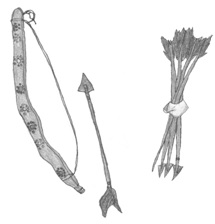 Although projectile points found on archaeological sites are commonly referred to as “arrow heads” American Indians* did not always have the bow and arrow. It was not until about A.D. 500 that this technology was adopted. Other tools were used in the more than 10,000 years previous to this. The first projectiles people used in Iowa were likely spears. The main advantages of the bow and arrow compared to the spear are more rapid missile velocity, higher degree of accuracy, and greater mobility. Arrowheads also required substantially less raw materials than spear heads. A flint knapper could produce a large number of small projectile points from a single piece of chert. Bow and arrow technology was retained into the early part of the Historic Period.
Although projectile points found on archaeological sites are commonly referred to as “arrow heads” American Indians* did not always have the bow and arrow. It was not until about A.D. 500 that this technology was adopted. Other tools were used in the more than 10,000 years previous to this. The first projectiles people used in Iowa were likely spears. The main advantages of the bow and arrow compared to the spear are more rapid missile velocity, higher degree of accuracy, and greater mobility. Arrowheads also required substantially less raw materials than spear heads. A flint knapper could produce a large number of small projectile points from a single piece of chert. Bow and arrow technology was retained into the early part of the Historic Period.
In some instances, as recorded by Jesuit missionary-explorer Père Claude Aloués, bows continued to be used after the introduction of guns. Even with the many advantages of guns, bows and arrows are much quieter and much more rapid than early muzzle-loading guns, allowing the hunter more chances to strike at the prey. Indians used arrows to kill animals as large as bison and elk. Hunters approached their prey on foot or on horseback, accurately targeting vulnerable areas.
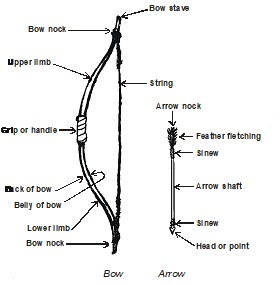
Bow and Arrow Terminology
Raw materials were not randomly chosen for constructing bow and arrows. Some materials were generally more readily available than others. Humidity alters the effectiveness of wooden bows. Temperature affects horn and antler. The intended use of the bow and arrow system, on foot or horse back, for instance, affects the final design. Bows used while mounted on horseback tend to be shorter than bows used when on foot.
The length of the bow determines the amount and kinds of stress placed on the bow when drawn. For this reason, shorter bows tend to be made of composites of different materials while bows used when on foot tend to be made of wood. Indians used a variety of materials to make the bow stave, relying on materials that met certain requirements, the most important of which is flexibility without breaking.

Examples of North American Bows
Several species of plants and some animal materials common to Iowa and surrounding areas met these requirements. Ash, hickory, locust, Osage orange, cedar, juniper, oak, walnut, birch, choke cherry, serviceberry, and mulberry woods were used. Elk antler, mountain sheep horn, bison horn, and ribs, and caribou antler also were used where available.
Bow designs used included a single stave of wood (self bow), wood with sinew reinforcement (backed bow), and a combination of horn or antler with sinew backing (composite bow). Hide glue was used to attach the backing. Bow strings most frequently were made of sinew (animal back or leg tendon), rawhide, or gut. The Dakota Indians also used cord made from the neck of snapping turtles. Occasionally, plant fibers, such as inner bark of basswood, slippery elm or cherry trees, and yucca were used. Nettles, milkweed, and dogbane are also suitable fibers. Well-made plant fiber string is superior to string made of animal fibers because it holds the most weight while resisting stretching and remaining strong in damp conditions. However, plant fiber strings are generally much more labor intensive to make than animal fiber strings, and the preference in the recent past was for sinew, gut, or rawhide.
Arrow shafts were made out of shoots, such as dogwood, wild rose, ash, birch, chokecherry, and black locust. Reeds from common reed grass were also used with some frequency throughout North America with the exception of the Plains where reeds did not grow. Shoots were shaved, sanded, or heat and pressure straightened. Tools made of bone, wood, sandstone, pumice and naturally occurring clinkers or burnt lignite were used to straighten the shaft wood. Experimental archaeology has found bedrock outcrops in the Des Moines River Valley in Iowa to produce excellent raw materials for shaft-abraders.
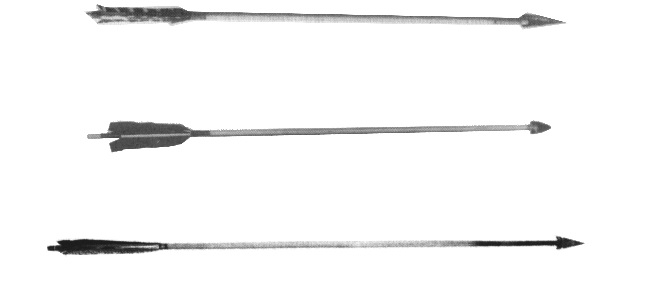
Because they are hollow and light, reed-shaft arrows typically have a wooden foreshaft and sometimes a wooden plug for the nock end of the arrow. If a foreshaft was used, it could be glued to the main shaft, tied with sinew, or fit closely enough to not need glue or sinew.
Points were attached to the arrow shaft with a variety of methods. Most frequently, the arrow shaft would have a slit cut into the end to accept the point. Sinew would then be wrapped around the shaft to pinch the slit closed. Points could also be hafted directly by wrapping sinew around the point and the arrow shaft. Metal points generally were attached using the same techniques and only infrequently attached by means of a socket.
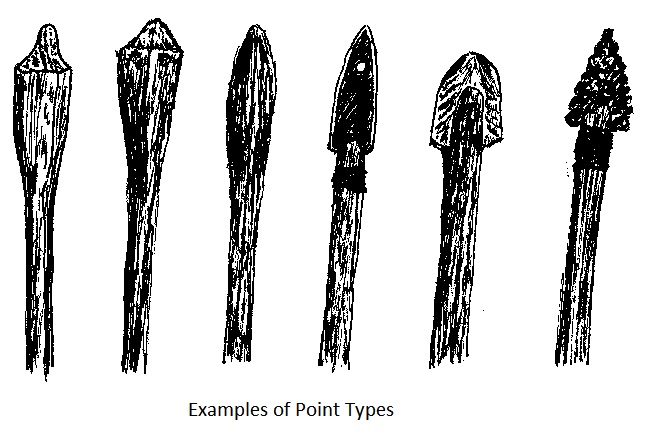
Indians made many types of arrowheads. In addition to the traditional triangular stone arrowhead, carved wood or leather points have large, broad surfaces. Prehistoric points or heads were made of stone, antler, or bone. Thin metal, bottle glass, and flint ballast stones also were used to make points in the historic period. Different types of arrow tips were used for different purposes, such as for large game versus small game. Large, blunt-tipped wooden points were used for birds. Small triangular stone points were used on large animals because the small, sharp points could more easily penetrate their thick hides. Harpoon-like points also exist and were used in fishing as an alternative to hooks, nets, or weirs.
Fletching of bird feathers was sewn to or inserted in a groove cut into the arrow shaft. Fletching balances the weight of the arrowhead to prevent the arrow from tumbling end-over-end in flight. When fletched properly, an arrow may spin in flight producing an ideal trajectory. A similar effectiveness is gained by placing grooves in the barrel of a rifle to cause the bullet to spin. In fact, until the invention of rifled guns, bows generally proved to be more accurate and could shoot arrows further than powder-thrown missiles. Feathers of wild turkey were preferred but many other birds, including eagle, crow, goose, hawk, and turkey, were often used. Sinew was generally used to attach the fletching by first stripping some of the feathers from the front and back of the vane and then tying the vane to the shaft in front of and behind the remaining feathers. Sometimes plant twine was used to sew through the quill. Hide glue was used with or instead of sinew ties. Animal products like sinew have the advantage of tightening as they dry.
The bow and arrow is a complex technology. Each element of the bow, arrow, and archer must be in balance to the proportions of the others to make an effective tool. The power of a bow is measured in terms of draw weight. The bow acts as a pair of springs connected by the grip or handle. As the string is pulled the material on the inside or belly of the bow limbs compresses, while the outside or back is stretched and is placed under tension. This action stores the energy used to draw back the string. When the string is released, the limbs quickly return to their state of rest and release the energy stored in the drawn string. The height and strength of the archer determines the ideal draw weight of the bow. A combination of the length of draw and the draw weight of the bow determines the cast (propelling force) of the bow. Adjusting either or both of these features allows the arrowhead to be made larger or smaller as needed.
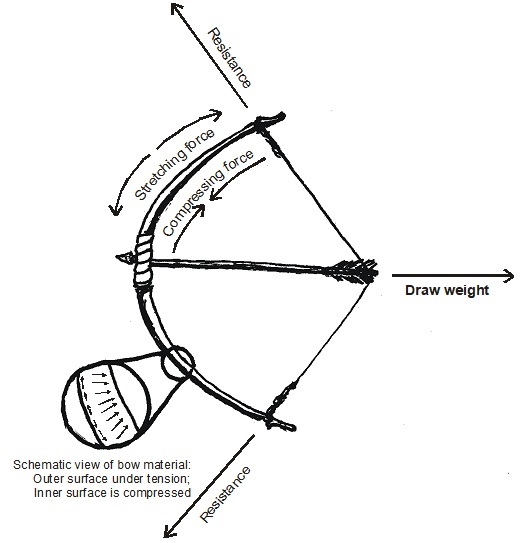
The draw weight of the bow also determines the ideal weight and diameter of the arrow shaft. Even a bow with a high draw weight can only throw an arrow so far. If the arrow is too heavy, it will not fly far or fast enough to be very useful. A shaft that is too thick or too thin will also lead to problems. The shaft must compress enough to bend around the bow stave as the string launches it. If it does not bend, the arrow flies to the side of the target. If it bends too much, it will wobble, reducing the striking force. The arrow may even shatter.
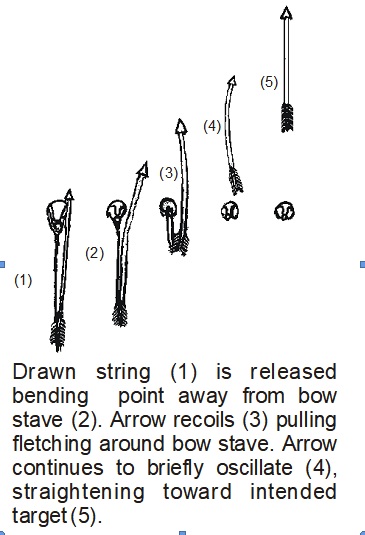
The length of the draw, also determined by the body of the archer, determines the length of the arrow. The maximum cast of the bow determines the maximum weight of the point. This is how we know that certain “arrowheads” can not really have been used on an arrow, at least not to any good effect. A general rule of thumb is that a stone arrowhead will be less than 1½-x-¾-inch in dimensions and will generally weigh less than one ounce. Larger “arrowheads” probably would have been spear, dart, or knife tips.
References
Ackerman, Laura B. (1985) The Bow Machine, Science 85, July/August, pp. 92-93.
Allely, Steve, and Jim Hamm (1999) Encyclopedia of Native American Bows, Arrows & Quivers: Volume 1: Northeast, Southeast, And Midwest. Lyons Press, New York.
Allely, Steve et al. (1992) The Traditional Bowyer’s Bible, Volumes 1-3. Lyons & Burford, New York.
Hamilton, T.M. (1982) Native American Bows. Special Publications No. 5, Missouri Archaeological Society, Columbia, Missouri
Hamm, Jim (1991) Bows & Arrows of the Native Americans. Lyons and Burford, New York. [Guide to construction]
Hardy, Robert (1992) Longbow: A Social and Military History. Lyons and Burford, New York. [Appendix has detailed description of physics related to bow and arrow]
McEwen, Edward, Robert L. Miller, and Christopher A. Bergman (1991) Early Bow Design and Construction, Scientific American, June 1991, pp. 77-82.
Pope, Saxton T. (1962) Bows and Arrows. University of California Press, Los Angeles.
Stockel, Henrietta H. (1995) The Lightening Stick: Arrows, Wounds, and Indian Legends. University of Nevada Press, Reno.
Thwaites, Ruben Gold, ed. (1900) The Jesuit Relations and Allied Documents: Travels and Explorations of the Jesuit Missionaries in New France 1610–1791 (60). Burrows Brothers, Cleveland.
Hurley, Vic (1975) Arrows Against Steel: The History of the Bow. Mason Charter, New York. [Discussion of effectiveness off the bow compared to firearms]
*Various terms are used to describe the indigenous or native peoples of North America, including Indian, American Indian, Native American, and so on. Each proves problematic in certain contexts. Professor June Helm, for whom I was a research assistant, preferred Amerind or American Indian. Others I worked with preferred Native American. However, communication with the OSA Indian Advisory Council indicated Indian was a good a term as any.
The text and illustrations originally appeared in print form in the Office of the State Archaeologist Series in Ancient Technologies. I’ve republished it here to restore the images of from the pamphlet. The text and illustrations are by Tim Weitzel. The cover art by Pranik Saiyasith who won a competition hosted by the OSA Education Committee. The original pamphlet was made possible through a grant from the Iowa Science Foundation administered by the Iowa Academy of Science

